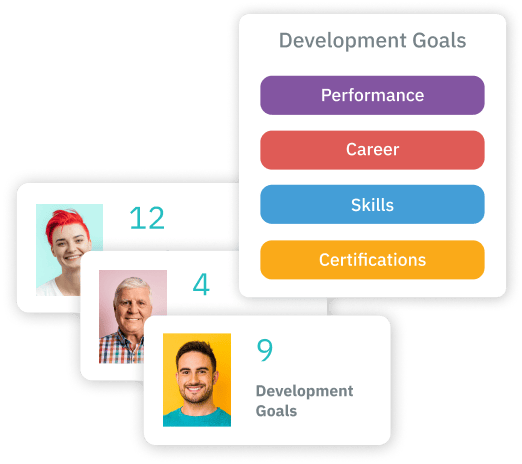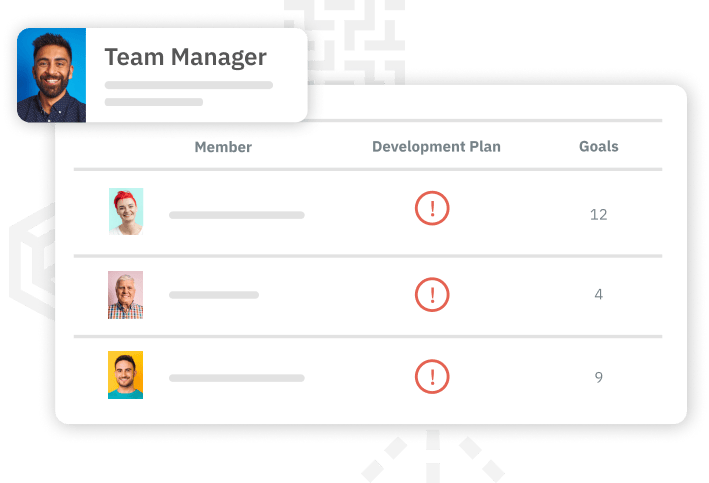Employee Development Planning Software
Keep professional growth on the front burner
Give employees the learning opportunities they crave, and cultivate their skills to support your company’s future. We make it easy to keep development top-of-mind, so your best talent stays engaged and your workforce can meet the demands of a rapidly changing business world.


Employee-driven goal setting
Empower employees to kickstart their own development path which provides suggestions based on their current skills, preferences, and other information in their Talent Profile.

Visibility for employees and managers
Enable employees to track career development goals all year long, and help managers monitor their team’s progress, provide real-time feedback and recognize achievements.

Easy progress tracking
Provide flexible tools for measuring goal attainment, including journal entries, activity tracking, 360 feedback, and assessments.

Optimize your learning opportunities
Employees get content learning suggestions based on their development goals, so they can take action quickly and make the best use of the company’s training resources.
See How Our Platform Helps You Build a Future-Ready Workforce
TalentGuard works best with organizations of 500+ employees in the U.S., Europe, Latin America, and regions within six hours of Central U.S.
Every company is at a different stage. Some need to clean up messy job titles and skills first. Others are focused on readiness, mobility, or succession.
Our bundles are built to match those realities. Pick the bundle that’s closest to where you are today, and we’ll tailor the demo to your needs. If you’re unsure whether we serve your region or use case, email info@talentguard.com and we’ll help you find the best fit.
Automate
Create skill profiles, create detailed job descriptions, align learning content with specific skills, and chart clear career path progressions to set the foundation for effective talent management.
Automate includes:
- Create Skill and Competency Profiles
- Develop Job Descriptions
- Map Learning to Skills and Competencies
- Map Career Path Progressions
Assess
Effectively assess their employees’ skills, identify gaps, and implement strategies to develop a skilled and competent workforce prepared to meet current and future challenges.
All the Automate features plus the ability to:
- Create a Skills Inventory
- Conduct Gap Analysis
Engage
Organizations can significantly enhance their talent development strategy and workforce effectiveness by assessing employee skills, curating personalized learning paths, recommending appropriate career paths, and tracking career goals.
All the Automate features plus the ability to:
- Assess Employee Skills and Competencies
- Curate Personalized Employee Learning Paths
- Recommend Employee Career Paths
- Track Career Goals
Optimize
Building talent pools, measuring employee performance, tracking certifications, and conducting multi-rater feedback enhance talent management, ensure compliance, and foster organizational leadership development.
All the Engage features plus the ability to:
- Build Talent Pools
- Measure Employee Performance
- Track Employee Certifications
- Conduct Multi-Rater Leadership Feedback
Trusted by Leading Companies Worldwide




Your Workforce is Evolving — Be Ready for What’s Next
Read our eBook
Additional information
The Great Resignation of 2021 not only surprised employers across the nation but also revealed secrets for employees. Spurred on by the opportunity to spend more time at home with family, workers simply decided that the jobs they had were not the jobs they ultimately wanted. There were several reasons for this mass dissatisfaction, and an important one was the lack of prospects for career growth.
In other words, many who walked away felt stuck in meaningless or dead-end jobs. And while no company wants to own this moniker, many human resource departments don’t understand the steps required to avoid it.
Your organization can sidestep this pitfall by providing opportunities for employee development planning. Why is employee development significant? Because it allows employees to set SMART goals for career development. Examples include:
- Mastering new technology or software
- Polishing leadership skills
- Gaining valuable work certifications or college credits
- Becoming more promotable
- Increasing individual job satisfaction
Previously, the worker’s responsibility to become a more marketable employee fell squarely on them. But in today’s world, more and more employees demand that their companies step up and help shoulder the burden. This is where a clearly defined employee development plan, goals, examples, and measured outcomes become vital. Having a plan such as this and training your employees to take advantage of it will help lower turnover rates, improve employee morale, and boost your company’s rank as a corporation that cares about worker satisfaction.
If your goal is to become a company where experienced and quality employees want to remain, adopting a strong employee development plan with personalized learning and business goals is an ideal place to begin.
Frequently Asked Questions
What is an employee development program?
An employee development program is a structured initiative that blends training, mentoring, and goal setting to help team members build the skills they need for current roles and future opportunities. Self-service tools help employees set milestones, personalized learning paths guide their progress, regular feedback loops drive improvement, and progress tracking keeps professional growth front and center.
What is the best software for employee development?
The best employee development software combines intuitive self-service interfaces, automated progress tracking, and targeted learning recommendations. Look for platforms that integrate performance data, enable agile goal-setting, and align individual plans with business objectives—features that power engagement and measurable outcomes.
How to write an employee development plan?
Start by identifying each employee’s career aspirations and the key competencies they need to reach them. Use SMART (Specific, Measurable, Achievable, Relevant, Time-bound) goals to define clear milestones, then map those goals to learning resources and mentorship opportunities. Schedule regular check-ins to review progress, adjust objectives, and celebrate achievements.
How much does employee training software cost?
Employee training and development software pricing varies widely based on features, user counts, and deployment models. Entry-level plans often start around $5–$10 per user per month, while enterprise solutions with advanced analytics, integrations, and custom branding can range from $20 to $50+ per user per month. Always request a tailored quote and demo to match costs with your specific needs.
Is employee development worth it?
Absolutely. Companies that invest in employee development software and structured growth plans see higher retention, boosted morale, and stronger bench strength for future leadership roles. By aligning individual ambitions with strategic goals, you cultivate a more engaged, capable workforce, and the ROI shows up in productivity gains and reduced turnover costs.
Personal and Professional Goals
For most employees, work goals fall into two categories: personal and professional goals. These are different for every worker, and not everyone places equal emphasis upon them. For many, the focus is on individual objectives. Examples include having more time to spend at home with family, the opportunity to contribute to an employee-sponsored savings plan, or more flexibility regarding paid time off.
Suppose you’ve lamented the time it takes to drive to work every morning or become frustrated with the traffic during the evening drive home. In that case, you’re familiar with personal work objectives. These features would make you feel happier and more content with your job, even when away from your desk.
Conversely, other employees place higher value on professional goals, examples of which may include a good opportunity for internal advancement or tuition assistance to earn college credits toward a degree. These work goal examples indicate what many of today’s applicants think when they apply. They also factor into how long an employee remains at a job. In other words, to attract and retain the nation’s best and brightest employees, it’s up to a corporation to provide enticing incentives that employees both want and need.
Employee Development Program
For instance, you may wish your receptionist would accept the role of office manager because you find them to be responsible, dedicated, and highly knowledgeable. However, they may not enjoy the extended hours or the switch from hourly to salaried pay. Having this information available upfront can save you both the time and frustration caused by placing a good employee in a role they don’t aspire to. Intense employee training and development programs will help you avoid problems like these.
What could prevent the devising of these employee development programs? Insufficient software training for HR personnel and unclear benefit briefings that leave employees disengaged can derail your development program. Training should be versatile to fit every individual’s schedule and preferences. Some prefer to learn in person, while others opt for online webinars or video conferences.
Career Development Plan for Employees
- Become a more confident public speaker
- Take a class in filing or transcription
- Become certified in office software
Your career development plan for employees should include posting internal positions where everyone can learn about them. It should spell out the job requirements in clearly defined terms that are easy to understand. Ideally, this will result in higher employee satisfaction rates and benefit both employees and managers by improving communication during job performance reviews.
Examples of career development goals for performance review include opportunities for improvement, such as punctuality or proper work attire. They also cover employee strengths. Using this information, workers can devise clear development goals to help them prepare for advancement along their preferred career paths, and managers can document the employee’s improved trajectory.
What Is Performance Development?
Help employees own their growth journey
Employees thrive when they take charge of their career development, and with modern employee development software, organizations can empower individuals to chart personalized growth paths. Our self-service tools enable employees to set milestones, target new skills, and flag improvement areas through an intuitive interface. This shift turns development into an engaging, employee-led experience rather than a passive HR task.
When you adopt powerful employee development planning software, workers tap into custom learning paths, connect directly with mentors, and track their progress in real time. Integrating performance data and competency models provides actionable insights, helping employees match their aspirations with organizational needs. For example, linking to a dedicated development planning software page lets employees explore features that align learning with career goals.
Track progress effortlessly with automated goal insights
Keeping tabs on development progress shouldn’t feel like busywork. Our development plan software tracks progress automatically and alerts you the moment a milestone hits—or if a goal needs your attention. Managers get dynamic dashboards that showcase team-wide wins, while each employee sees a personalized feed spotlighting upcoming tasks and recent achievements.
Seamless integration with employee training and development software ensures that every completed course, certification, or project update feeds directly into goal metrics. Notifications prompt action—whether it’s a reminder to solicit 360° feedback or to log journal entries—so progress never stalls. Automating these insights frees up time for coaching and meaningful conversations.
Bridge skills gaps with targeted learning recommendations
A critical feature of the best employee development software is its ability to diagnose skills gaps and instantly suggest relevant learning resources. Using data from skills inventories and performance reviews, the platform curates personalized learning paths—from microlearning modules to certification courses—so employees can address gaps before they impact productivity.
By leveraging algorithms that match competency requirements with available content, you deliver precise recommendations that resonate with each employee’s aspirations. Whether it’s an online leadership workshop or a technical certification, targeted recommendations make development actionable. As a result, employees stay engaged, and your company benefits from a more capable, future-ready workforce.
Align individual plans with business objectives
True ROI on development initiatives comes when your employee development plan software maps individual goals directly to organizational objectives. Employee development planning software enables HR teams to map individual goals directly to organizational objectives—closing a critical skills gap, preparing successors for key roles, or driving innovation in new markets. This alignment ensures every development activity contributes to broader business outcomes.
Our platform’s agile goal-setting frameworks make the purpose behind every target unmistakable. We conduct frequent check-ins and distribute crisp progress reports that link each achievement to core business metrics, fueling accountability and teamwork. We boost engagement and drive sustainable organizational success by tying career growth to strategic priorities.

